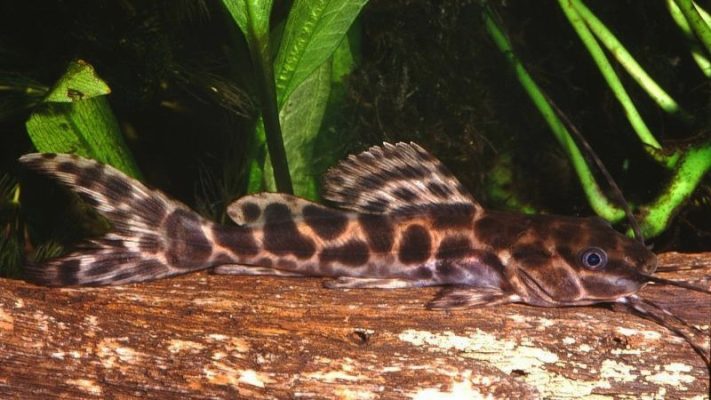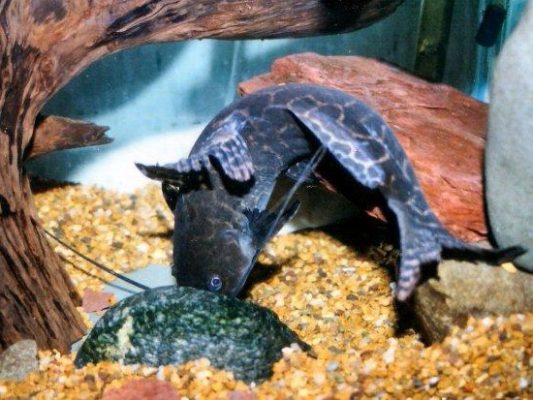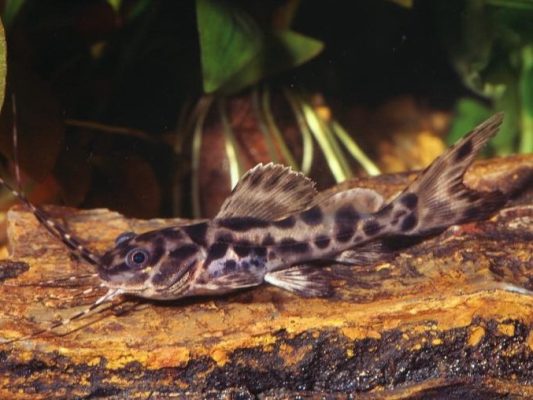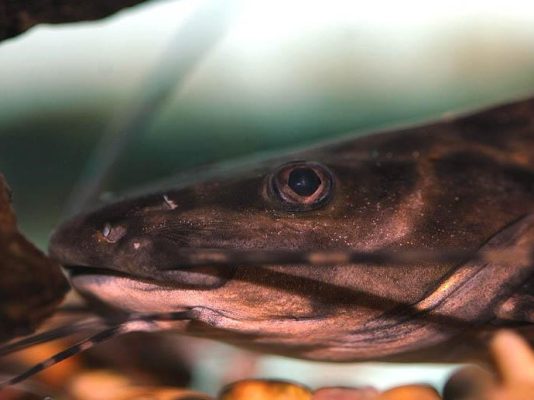Leiarius Marmoratus

Table of Contents
Introduction
Leiarius marmoratus, commonly known as the Achara catfish, is a species of large catfish native to the Amazon region. This fascinating species possesses unique characteristics that make it an important component of the aquatic ecosystem.
The Achara catfish is known for its impressive size, with adults reaching lengths of up to 1 meter and weighing over 20 kilograms. Its body is elongated and muscular, allowing it to navigate through the dense vegetation and strong currents of its freshwater habitats. The species is easily recognizable due to its distinctive markings, which consist of dark, mottled patterns on a light background.
One of the key reasons why Leiarius marmoratus is significant in the aquatic ecosystem is its role as a top predator. As an apex predator, it helps to regulate the population of other fish species, ensuring a balanced ecosystem. Additionally, the Achara catfish plays a crucial role in nutrient cycling. Its feeding habits contribute to the decomposition of organic matter, which in turn enriches the surrounding environment.
Furthermore, Leiarius marmoratus is an indicator species, meaning its presence or absence can indicate the overall health of the ecosystem. As a result, monitoring the population trends and conservation status of this species can provide valuable insights into the overall well-being of the Amazon region.
The Achara catfish also holds cultural and economic importance for local communities. It has been a staple food source for many indigenous populations living in the Amazon for centuries. Additionally, it is highly sought after by anglers and fish enthusiasts due to its impressive size and unique appearance.
Leiarius marmoratus, or the Achara catfish, is a remarkable species of large catfish native to the Amazon. Its unique characteristics, role as a top predator, and cultural and economic significance make it a species worthy of study and conservation efforts. Understanding and conserving Leiarius marmoratus is crucial for the preservation of the Amazon ecosystem and the well-being of local communities. Further research and conservation initiatives are needed to ensure the long-term survival of this fascinating species.
Taxonomy
Classification and scientific name of Leiarius marmoratus
Leiarius marmoratus, commonly known as the Achara catfish, belongs to the taxonomic family Pimelodidae and the order Siluriformes. Its scientific name is Leiarius marmoratus.
The classification of Leiarius marmoratus is as follows:
- Kingdom: Animalia
- Phylum: Chordata
- Class: Actinopterygii
- Order: Siluriformes
- Family: Pimelodidae
- Genus: Leiarius
- Species: marmoratus
Description of its taxonomic family and order
Leiarius marmoratus is a member of the family Pimelodidae, which is commonly referred to as the long-whiskered catfish family. This family includes over 100 species of catfish, characterized by their long barbels and slender bodies. Pimelodidae is known for its diverse range of habitats, with species found in freshwater environments throughout South America.
The order Siluriformes, to which Leiarius marmoratus belongs, comprises over 3,000 species of catfish. Siluriformes is one of the largest orders of freshwater fishes and is known for its unique adaptations, such as the presence of barbels and the absence of scales. Catfish in this order exhibit a wide variety of sizes, shapes, and behaviors, making them a fascinating group to study.
Comparison to other related species
Leiarius marmoratus can be distinguished from other related species by several key features. One notable characteristic is its large size, as it can reach lengths of up to 1 meter (3.3 feet) and weigh up to 15 kilograms (33 pounds). This sets it apart from many other catfish species, which tend to be smaller in size.
Another distinguishing feature of Leiarius marmoratus is its unique coloration and markings. It has a dark brown to blackish body with irregularly shaped light-colored spots or marbling, which gives it its specific epithet “marmoratus,” meaning “marbled” in Latin. This coloration helps it blend in with its surroundings in the murky waters of the Amazon.
In comparison to other catfish species within the family Pimelodidae, Leiarius marmoratus stands out due to its long barbels, which can extend well beyond the length of its head. These barbels are sensory organs that help the catfish locate food and navigate its environment.
When compared to other catfish species in the order Siluriformes, Leiarius marmoratus exhibits a unique combination of physical characteristics, including its large size, marbled coloration, and elongated barbels. These features make it a distinct and fascinating species within its taxonomic group.
By understanding the taxonomy of Leiarius marmoratus and comparing it to other related species, we can gain a deeper appreciation for its unique attributes and its place within the diverse world of catfish.
Physical Characteristics
Size and Weight Range of Leiarius marmoratus
Leiarius marmoratus, commonly known as the Achara catfish, is a species of large catfish native to the Amazon region. Adult Leiarius marmoratus typically measure between 24 to 30 inches (60 to 75 cm) in length, although there have been reports of individuals growing up to 36 inches (90 cm) long. In terms of weight, these catfish can range from 10 to 20 pounds (4.5 to 9 kg), with some exceptional specimens weighing even more.
Description of Body Shape, Coloration, and Markings
The physical appearance of Leiarius marmoratus is truly remarkable. Its body is elongated and cylindrical, tapering towards the tail. The head is large and broad, with a slightly flattened top. The body is covered in small, overlapping scales that are dark in color, ranging from shades of brown to black. These scales give the fish a mottled and marbled appearance, which is why it is also known as the “marmoratus” catfish.
One of the most distinctive features of Leiarius marmoratus is its large, deeply forked tail fin, which aids in its powerful swimming abilities. Additionally, this species possesses long, whisker-like barbels that extend from its snout. These barbels are highly sensitive and help the catfish navigate its surroundings and locate prey.
Examination of Unique Features, such as Long Barbels and Dorsal Fin Structure
The long barbels of Leiarius marmoratus are a key characteristic of this species. These barbels, which can grow to be as long as the fish itself, are covered in taste buds and sensory cells. They serve multiple purposes, including detecting food sources, sensing changes in water currents, and even communicating with other catfish.
Another notable feature of Leiarius marmoratus is its dorsal fin structure. The dorsal fin, located on the upper surface of the fish, is elongated and extends along a significant portion of its back. This fin is supported by strong and flexible rays, allowing the catfish to make precise movements and maintain stability while swimming.
The coloration and patterns commonly seen on Leiarius marmoratus vary depending on the individual and their environment. Juvenile catfish often display a more vibrant coloration, with a combination of dark brown, black, and yellowish hues. As they mature, the coloration tends to darken and become more uniform, blending in with their surroundings.
In conclusion, Leiarius marmoratus possesses a unique set of physical characteristics that make it easily distinguishable from other catfish species. Its large size, marbled appearance, long barbels, and prominent dorsal fin contribute to its overall impressive presence in the aquatic ecosystem. Understanding and appreciating these physical traits are crucial for the conservation and management of this fascinating species.
Habitat
Geographic distribution of Leiarius marmoratus
Leiarius marmoratus, commonly known as the Achara catfish, is primarily found in the vast and diverse Amazon region. This species is native to the freshwater ecosystems of South America, specifically in countries such as Brazil, Peru, Colombia, and Venezuela. The Amazon basin, with its intricate network of rivers, tributaries, and flooded forests, provides an ideal habitat for the Achara catfish.
Preferred freshwater habitats, such as rivers, lakes, and flooded forests
Leiarius marmoratus is known to inhabit a variety of freshwater habitats within the Amazon region. It can be found in large rivers, such as the Amazon River itself, as well as its tributaries and smaller streams. These catfish are also commonly found in lakes, lagoons, and oxbow lakes formed by the changing course of rivers over time. Additionally, they have been observed in flooded forests during the rainy season when water levels rise and inundate the surrounding land.
Discussion of specific regions where Leiarius marmoratus is commonly found
Leiarius marmoratus is commonly found in various regions throughout the Amazon basin. In Brazil, it is frequently encountered in the states of Amazonas, Pará, and Amapá. In Peru, it can be found in the Loreto and Ucayali regions. In Colombia, it is often observed in the Amazonas and Vaupés departments. Venezuela’s Amazonas state is also known to be a habitat for this species.
Within these regions, the Achara catfish tends to inhabit areas with slow-moving or stagnant water, such as backwaters, flooded forests, and areas with submerged vegetation. These habitats provide the necessary cover and food sources for Leiarius marmoratus to thrive.
Research conducted by biologists and ichthyologists has contributed to our understanding of the specific microhabitats favored by Leiarius marmoratus. For example, studies have shown that they prefer areas with fallen trees and submerged logs, which provide shelter and foraging opportunities. These structures create complex habitats where the Achara catfish can hide, hunt, and reproduce.
Furthermore, it is worth noting that Leiarius marmoratus is an adaptable species, capable of tolerating a wide range of water conditions. It can be found in both clear and turbid waters, and it can tolerate low oxygen levels, which are common in some parts of the Amazon basin.
Understanding the specific regions and habitats where Leiarius marmoratus is commonly found is crucial for conservation efforts. By identifying and protecting these areas, we can ensure the long-term survival of this remarkable species and contribute to the overall health and biodiversity of the Amazon ecosystem.
Behavior
Nocturnal Nature of Leiarius marmoratus
Leiarius marmoratus, commonly known as the Achara catfish, exhibits a fascinating nocturnal nature. It is primarily active during the nighttime hours and relatively inactive during the day. This behavior is believed to be an adaptation to its natural habitat in the Amazon, allowing it to avoid predators and take advantage of the cover of darkness.
Studies have shown that Leiarius marmoratus displays distinct activity patterns during the night. It actively hunts for prey, explores its surroundings, and engages in various social behaviors. The darkness provides a sense of security for the fish, enabling it to roam freely and search for food without the risk of being spotted by predators.
Feeding Habits and Diet Preferences
Leiarius marmoratus is a carnivorous species with specific diet preferences. Its feeding habits are closely related to its nocturnal nature, as it primarily hunts for food during the night. The catfish is known to be an opportunistic predator, consuming a wide range of prey depending on availability.
In its natural habitat, Leiarius marmoratus feeds on a variety of aquatic organisms, including smaller fish, crustaceans, and insects. It is particularly skilled at ambushing its prey, using its large size and powerful jaws to capture and devour its victims. The catfish possesses sharp teeth that aid in grasping and tearing apart its prey, ensuring a successful hunt.
Social Behavior and Interaction with Other Fish Species
Leiarius marmoratus exhibits interesting social behavior, especially during its nocturnal activities. While it is generally a solitary species, there have been observations of small groups of Achara catfish congregating in certain areas of their habitat. These groups are believed to be formed for various reasons, such as mating or foraging.
During these social interactions, Leiarius marmoratus displays a hierarchical structure, with dominant individuals asserting their dominance over subordinate ones. This behavior is often seen during feeding, where the dominant catfish will claim the best feeding spots and defend them from other individuals.
Furthermore, Leiarius marmoratus has been observed to interact with other fish species in its habitat. These interactions can vary from mutual tolerance to aggressive behavior, depending on the circumstances and availability of resources. It is not uncommon for the Achara catfish to compete with other fish for food or territory, leading to territorial disputes or even predation.
Migration Patterns, if Applicable
Migration patterns in Leiarius marmoratus are not well-documented, and further research is needed to fully understand this aspect of its behavior. However, there have been some anecdotal reports of seasonal movements in certain populations of Achara catfish.
These movements are believed to be triggered by changes in water levels, temperature, or food availability. During these migrations, Leiarius marmoratus may travel long distances in search of suitable habitats or breeding grounds. These movements can have significant ecological implications, as they contribute to the dispersal of the species and the maintenance of genetic diversity.
Understanding the migration patterns of Leiarius marmoratus is crucial for effective conservation and management strategies. By identifying key migration routes and critical habitats, conservation efforts can be targeted to ensure the long-term survival of this remarkable species.
In conclusion, Leiarius marmoratus exhibits a nocturnal nature, displaying distinct activity patterns during the night. It is an opportunistic predator with specific diet preferences and engages in social behavior, including hierarchical structures and interactions with other fish species. While migration patterns are not fully understood, there are indications of seasonal movements in certain populations. Further research is needed to unravel the complexities of the behavior of this fascinating species and to implement effective conservation measures to protect its habitat and ensure its long-term survival.
Reproduction
Mating behavior and courtship rituals of Leiarius marmoratus
Leiarius marmoratus, like many other catfish species, exhibits fascinating mating behavior and courtship rituals. During the breeding season, which typically occurs during the rainy season in the Amazon region, male Leiarius marmoratus actively seek out potential mates. They engage in elaborate courtship displays to attract females and establish their dominance.
The courtship rituals of Leiarius marmoratus involve various visual and tactile displays. Males often display their vibrant coloration and distinctive markings to attract females. They may also engage in vigorous fin-flaring and body movements to demonstrate their strength and fitness. These displays serve as visual signals to communicate their readiness to mate and their ability to provide for the offspring.
Once a male successfully attracts a female, they engage in a unique behavior known as “nudging.” The male nudges the female gently with his snout, stimulating her and encouraging her to release eggs for fertilization. This nudging behavior is a crucial part of the mating process for Leiarius marmoratus and helps ensure successful reproduction.
Description of its reproductive organs and breeding process
Leiarius marmoratus possesses well-developed reproductive organs that are essential for successful breeding. Both males and females have specialized structures that facilitate the fertilization and development of eggs.
Male Leiarius marmoratus have paired testes, located internally, which produce sperm. These testes are connected to a duct called the vas deferens, which carries the sperm to the urogenital papilla, a small opening located near the anal fin. During mating, the male releases sperm through the urogenital papilla to fertilize the eggs released by the female.
Female Leiarius marmoratus have a pair of ovaries that produce eggs. These eggs are released into the body cavity and then expelled through an oviduct, which is connected to the urogenital opening. The male’s nudging behavior stimulates the female to release eggs, which are then fertilized externally by the male’s sperm.
Gestation period and number of offspring produced
After successful fertilization, the female Leiarius marmoratus carries the fertilized eggs externally. The eggs are attached to the female’s pelvic fins by adhesive threads, forming a distinctive egg mass. The female guards and cares for the eggs until they hatch, providing them with protection and oxygenation by fanning them with her pectoral fins.
The gestation period for Leiarius marmoratus is approximately 7 to 10 days, depending on environmental conditions such as water temperature and oxygen levels. During this period, the female diligently tends to the eggs, ensuring their well-being and survival.
Leiarius marmoratus is known to produce a relatively large number of offspring in each reproductive cycle. A single female can produce hundreds or even thousands of eggs. This high fecundity is advantageous for the species, as it increases the chances of survival for at least some of the offspring in the face of predation and other environmental challenges.
Parental care and protection of the young
Leiarius marmoratus exhibits remarkable parental care and protection towards its young. After the eggs hatch, the female continues to guard the fry, providing them with protection and guidance. She remains close to the fry, ensuring their safety and leading them to suitable feeding grounds.
During this period, the female Leiarius marmoratus also displays an interesting behavior known as “mouthbrooding.” She takes the fry into her mouth, providing them with additional protection and shelter. This behavior is particularly important during the early stages of the fry’s development when they are most vulnerable to predation.
The female Leiarius marmoratus continues to care for the fry until they reach a certain size and are capable of surviving on their own. This parental care significantly increases the chances of survival for the offspring and contributes to the overall reproductive success of the species.
In conclusion, the reproduction of Leiarius marmoratus involves fascinating mating behavior, courtship rituals, and specialized reproductive organs. The species exhibits high fecundity, with females producing a large number of eggs in each reproductive cycle. The parental care and protection provided by the female towards the young ensure their survival and contribute to the long-term sustainability of Leiarius marmoratus populations in the Amazon ecosystem. Further research on the reproductive biology of this species will deepen our understanding of its unique adaptations and aid in conservation efforts.
Conclusion
Throughout this article, we have explored the fascinating world of Leiarius marmoratus, also known as the Achara catfish. We began by introducing this species as a large catfish native to the Amazon, highlighting its unique characteristics and emphasizing its importance in the aquatic ecosystem.
Moving on, we delved into the taxonomy of Leiarius marmoratus, providing its scientific name and classification. We also discussed its taxonomic family and order, comparing it to other related species and highlighting its distinguishing features.
In the section on physical characteristics, we explored the size and weight range of Leiarius marmoratus, describing its body shape, coloration, and markings. We also examined its unique features, such as its long barbels and prominent dorsal fin, which contribute to its distinct appearance.
Next, we explored the habitat of Leiarius marmoratus, explaining its geographic distribution and preferred freshwater habitats, including rivers, lakes, and flooded forests. We also provided information on specific regions where this species is commonly found.
Moving on to behavior, we highlighted the nocturnal nature of Leiarius marmoratus and discussed its feeding habits and diet preferences. We also explored its social behavior and interaction with other fish species, as well as any migration patterns it may exhibit.
In the section on reproduction, we described the mating behavior and courtship rituals of Leiarius marmoratus, providing information on its reproductive organs and breeding process. We also discussed the gestation period and the number of offspring produced, as well as the parental care and protection exhibited by this species towards its young.
Understanding and conserving Leiarius marmoratus is of utmost importance for the preservation of the Amazon ecosystem. As a species of large catfish, it plays a crucial role in maintaining the balance of the aquatic ecosystem. Its unique characteristics and behaviors contribute to the overall biodiversity of the region.
By studying and protecting Leiarius marmoratus, we can gain valuable insights into the intricate web of life in the Amazon. This species serves as an indicator of the health of its habitat, and any changes in its population size or distribution can provide valuable information about the overall well-being of the ecosystem.
As we conclude this article, it is evident that there is still much to learn about Leiarius marmoratus. Further research is needed to deepen our understanding of its biology, behavior, and ecological role. By conducting scientific studies and gathering more data, we can make informed decisions and develop effective conservation strategies.
The future prospects of Leiarius marmoratus depend on our commitment to its preservation. By raising awareness about this species and its importance, we can inspire action and encourage individuals, organizations, and governments to prioritize its conservation.
In conclusion, Leiarius marmoratus is a remarkable species of catfish that deserves our attention and protection. Through our collective efforts, we can ensure that this fascinating species continues to thrive in its natural habitat, contributing to the rich biodiversity of the Amazon and serving as a symbol of the interconnectedness of all life forms in this unique ecosystem.



